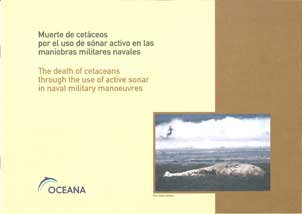Report | May, 2010
The death of cetaceans through the use of LFA sonar in naval military maneuvers
The appearance this summer of several cetaceans stranded on the coasts of the Canary Islands and the Azores while naval manoeuvres were being carried out has reopened the debate on the impact on cetaceans from the use of sonar and other acoustic pollution arising from these exercises.
This is not the first time this has happened in the Canary Islands, nor is this the only region in the world where the death of cetaceans has coincided with warship manoeuvres.
Despite the fact that the navies involved have repeatedly tried to deny their responsibility in these events, the fact is that both NATO and the US Navy have been aware of the cause of these deaths for years.
What is LFAS?
LFAS, or SURTASS LFAS, is the acronym for the high-precision SONAR system known as Surveillance Towed Array Sonar System, Low Frequency Active Sonar.
It is based on the use of high intensity sound waves (over 200 dB) at low frequency (between 450 and 700 Hz) that can travel great distances underwater and detect objects hundreds of kilometres away. Dozens of them are emitted in a matter of seconds (up to 250 within 4-5 seconds) and they hit objects and rebound to a receiver that interprets them and allows the object in question to be visualised. Sonar can also be used for a minute or more at a time at intervals of 10-15 minutes. This sound transmitter is suspended from the ship at a depth of around 50 metres.
However, it is known that NATO is continuing to experiment with systems at even lower frequency (50-150 Hz) and at a range of 230 dB, which would allow them greater reach and precision. Mid-frequency sonar is also being used, sometimes in combination with LFAS, with similar harmful effects. For this reason, both mid and low frequency sonar have been appointed as the cause for cetacean strandings. But the potential impact of LFAS is higher due to its range, and that lower frequencies can interact with whales’ sounds. Sound travels 4.5 times faster in water than in air and the lower the frequency (Hz) the further it can travel (hundreds of kilometres). In addition, the intensity (dB) is more consistent. Frequencies below 1 kHz lose barely 0.04 dB per kilometre.




